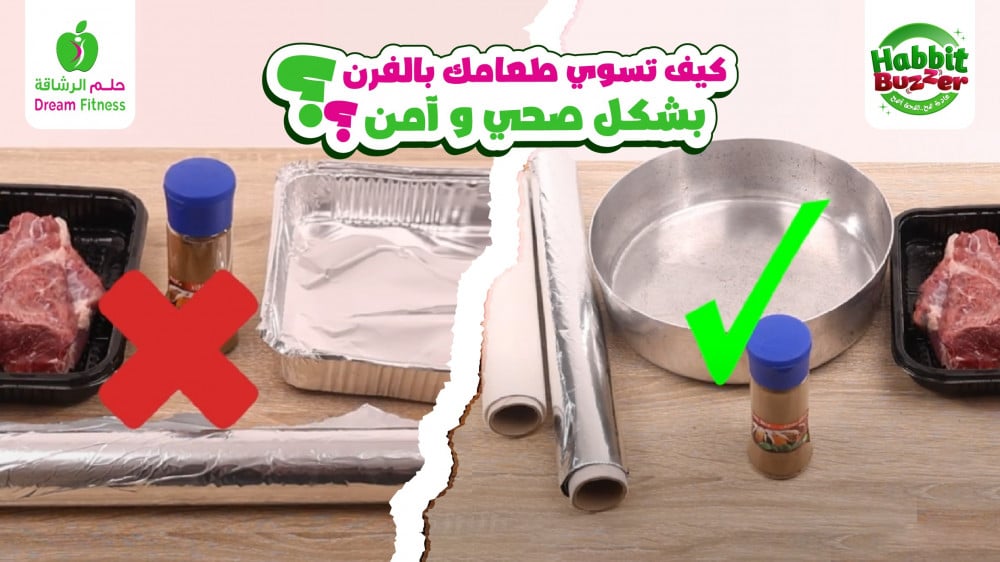Everyone cooks some type of food in the oven, where the nutritional values of the food are preserved and it is not exposed to oils and fats, but there are many mistakes we make and we do not know how dangerous they are.
Such as using aluminum foil to cover food or the container in which the food is before it enters the oven and exposes it to the temperature until it is cooked, but aluminum foil has many serious harms that we must know about.
- What is aluminum foil paper?
Aluminum foil, or tin foil, is a thin shiny sheet of aluminum metal. They are manufactured by rolling large sheets of aluminum to a thickness of less than 0.2 mm.
It is used industrially for a variety of purposes, including packing, insulation, and transportation. It is also widely available in grocery stores for home use.
At home, people use aluminum foil to store food, cover baking surfaces, and wrap foods, such as meat, to prevent them from losing moisture during cooking.
People may also use aluminum foil to wrap and protect delicate foods, and it is also used when grilling food.
It can also be used to line grill trays to protect pans or grill grates from stains and stubborn grease residue.
- Cooking with aluminum foil may increase the aluminum content in foods:
Studies indicate that aluminum foil, cooking utensils, and desserts can transfer aluminum to the food. This means that cooking with it may increase the aluminum content in the food. The amount of aluminum that passes into the food when cooking with it is affected by several things, such as
- When exposed to high temperature.
- Certain ingredients, such as the use of salts and spices in seasoning food.
However, the amount that percolates into food upon cooking can vary.
One study found that cooking red meat in aluminum foil can increase its aluminum content by 89%.
Such studies have raised concerns that regular use of aluminum foil in cooking may be harmful to health.
- Potential health risks from exposure to too much aluminum:
Daily exposure to aluminum through food and cooking is considered safe. Studies have shown that excessive exposure to aluminum is a factor that increases the likelihood of developing the following diseases:
- Alzheimer's disease Alzheimer's disease is a neurological condition caused by the loss of brain cells. People with this condition experience memory loss and decreased brain function.
- Liver dysfunction.
- Hormonal imbalance.
- Thyroid disorders.
- Infection with different types of cancer.
- Kidney disorders due to aluminum accumulation.
- Inflammatory bowel.
- How to reduce aluminum exposure when cooking:
- Avoid using it in cooking food. You can only use it to wrap ready-to-eat foods, but you must take care to use the glossy layer with hot foods and the matte layer with cold foods.
- Limit the use of aluminum foil, especially if you use it to wrap acidic foods, such as tomatoes or lemons.
- Use utensils that are not made of aluminum and replace them with dishes, glass or porcelain utensils.
- What is the alternative to aluminum foil?
Butter paper is the perfect alternative to using aluminum foil.
Parchment paper is a double-sided paper coated with fat, resistant to moisture and burning, and is used in cooking to avoid food sticking. Parchment paper is made from paper treated with acids, to give it validity and the ability to resist heat. It is also coated with a non-stick material such as silicone, and is used up to a temperature of 230c in convection ovens.
- How parchment paper is made:
Parchment paper is manufactured by making thin sheets consisting of paper pulp, then placing them in sulfuric acid or zinc chloride. The components begin to partially dissolve, enveloping the paper and depositing on it. A solid material with high stability, high density, and heat resistance is formed, so the paper becomes non-sticky and has excellent properties. Low surface energy, the appearance of treated parchment paper is similar to old vellum.
- Uses of parchment paper:
There are many uses for parchment paper in the kitchen and elsewhere, including:
- Cooking foods without fats, as parchment paper helps in cooking foods without any fatty materials.
- Prevent food from sticking to each other inside the freezer, such as: meat, chicken, fish, and other frozen foods.
- Place parchment paper at the bottom of food storage containers to avoid food residues sticking to them.
- An alternative to cupcake molds if they are not available
- It is also used to serve snacks and popcorn.
- Bakery packaging.
- Cover foods when reheating in the microwave
- If you cook some type of food in the oven:
- The food must be prepared and seasoned normally and naturally, and before it enters the oven, it must first be covered with parchment paper, then aluminum foil must be placed, but we must avoid direct contact of aluminum with the food.
References:

